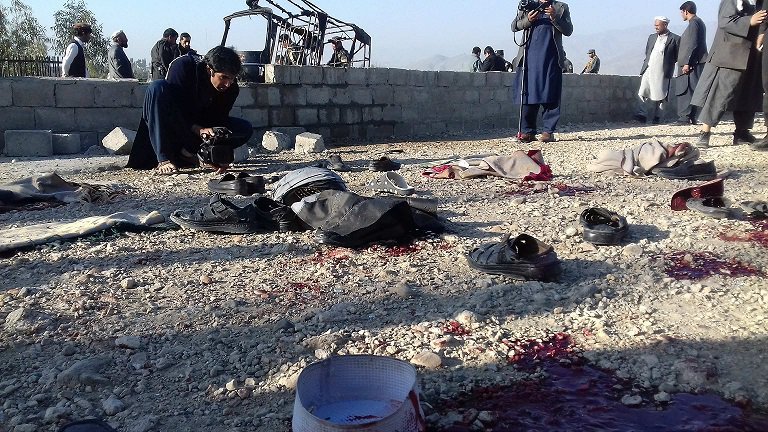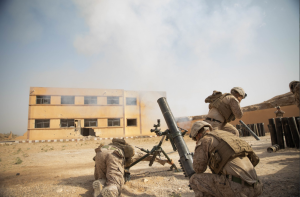by Edward Hunt
Seventeen years into the war in Afghanistan, the longest war in U.S. history, violence has never been worse. In 2017, more than 20,000 Afghans died, a new record.
The dead include an estimated 10,000 Afghan security forces, 10,000 Taliban forces, and 3,438 civilians. Although there is no reliable data on Afghan casualties available to the public, reports published by the Costs of War Project at Brown University indicate that the annual death toll for the Afghan population has never been higher than it was in 2017.
For civilians, the last four years of the war have been the deadliest, with more than 3,400 civilians killed each year from 2014-2017, according to data from the United Nations and the Costs of War Project.
“We are concerned that we will see greater harm this year unless necessary steps are taken by all parties to prevent civilian casualties,” said Tadamichi Yamamoto, the UN Secretary General’s special representative for Afghanistan.
The record violence comes as the Trump administration has intensified the war against the Taliban. Although President Trump repeatedly indicated before he was president that he opposed the war and wanted to end it, he has instructed U.S. military forces to take more aggressive action.
“In Afghanistan, I’ve lifted restrictions and expanded authorities for commanders in the field,” Trump acknowledged last year. The new approach, according to Brigadier General Lance Bunch, means that “the gloves are off.” U.S. military forces are now looking for “any opportunity to target the enemies of Afghanistan wherever we find them in the theater.”
With the new authorities, the U.S.-led coalition has been waging a more aggressive war. In 2017, U.S. forces tripled the number of airstrikes against enemy forces. They also helped Afghan security forces intensify offensive operations against the Taliban.
“In the last year, we’ve seen offensive operations, kind of unprecedented over the last few years, by the Afghan security forces,” U.S. General John Nicholson, the commander of coalition forces in Afghanistan, has commented.
Administration officials acknowledge that they expected the Taliban to respond to the increase in military pressure with more violence. “And so we anticipated this,” Secretary of Defense James Mattis has said. In March, State Department official Alice Wells remarked that “it will not come as a surprise if we see more terrorist tactics addressed at urban audiences.”
The increase in violence has been devastating for the Afghan people. According to the UN Assistance Mission in Afghanistan, which tracks civilian casualties, more than 3,400 Afghan civilians have died and more than 6,800 Afghan civilians have been injured in each of the past four years of the war.
Afghan officials quietly acknowledge that about 10,000 Afghan security forces died last year, a significant increase from previous years. Fearing that the publication of the numbers could undermine morale and hinder ongoing recruitment efforts in Afghanistan, the U.S. military has begun censoring the records.
Although U.S. and Afghan officials estimate that about 10,000 Taliban forces were killed in 2017, Gen. Nicholson has said that “enemy casualty rates have been much higher.” Either way, last year’s combined death toll for Afghan combatants is about 20,000 people.
Despite the record death toll, the Trump administration remains committed to its strategy. “Progress and violence coexist in Afghanistan,” Secretary Mattis recently commented.
The U.S. military’s primary objective is to bring at least 80 percent of the Afghan population under the control of the Afghan government. According to a classified study, the Afghan government might prevail in the war if it achieves this goal. “The focus of our military operations is on increasing and expanding population control by the government of Afghanistan,” General Joseph Votel, the commander of U.S. Central Command, told Congress earlier this year.
The Trump administration’s approach is failing. Not only are record numbers of Afghans dying, but the Afghan government has been losing control of the population. In its latest report to Congress, the Special Inspector General for Afghanistan Reconstruction confirmed that the Afghan government’s control has dropped from 69 percent in August 2016 to 65 percent in January 2018.
Last year, the U.S. intelligence community largely predicted the failures. Director of National Intelligence Daniel Coats told the Senate Armed Services Committee that “the political and security situation in Afghanistan will almost certainly deteriorate through 2018 even with a modest increase in military assistance by the United States and its partners.”
Former Secretary of Defense Chuck Hagel has said that the war has reached a new low. “After 17 years in Afghanistan the situation is worse than it’s ever been,” Hagel commented earlier this year.
Perhaps the best hope for Afghanistan now lies with a growing Afghan peace movement, which has been calling for an immediate ceasefire and talks to end the war. Not only has it succeeded in getting Afghan President Ashraf Ghani to announce a temporary ceasefire, but the Taliban announced its own ceasefire, leading to a few days of peace and celebrations throughout the country.
“I think President Ghani is responding to and indeed reflecting the desire of a wide cross-section of Afghans… in desiring to see a reduction in violence and a way forward to an end to the conflict,” a senior State Department official said.
The Afghan government plans to maintain the ceasefire for the immediate future, despite the recent decision by Taliban officials to resume fighting.
Edward Hunt writes about war and empire. He has a PhD in American Studies from the College of William & Mary.





